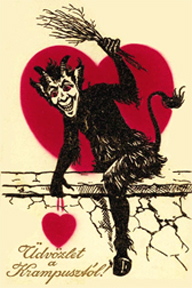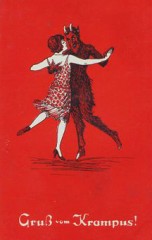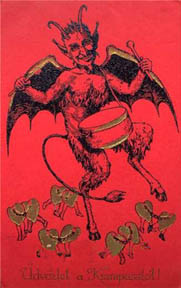
Krampus, The Valentine Devil -By Angelique Duncan
Krampus originated in early history as a winter holiday icon as the antithesis to St Nicholas or Santa Clause. He was a reminder to children to be good. He is the horned devil like creature with one human foot and one hove and a long tongue who would carry away naughty children in his basket to his liar in the Black Forest. In his early incarnations he was depicted as menacing and gruesome, a sight to be feared.
Greeting cards in the early nineteenth century with the frightening image of Krampus became popular as a way of giving warning to children that Krampus was watching. As the greeting card industry grew in popularity, images of Krmapus became more tongue in cheek and humorous in nature and were targeted to adults. Krampus remained sinister in his appearance despite his more comical and sometimes romantic escapades.

Krampus began to emerge in modern history on greeting cards in a more adult context depicted seducing and voyeuristically interacting with attractive and often scantly dressed women. This more romantic and erotic version of Krampus began to appear not only at Yule and Christmas time but found their way to the lowbrow Valentines Day greeting card market. Krampus evolved into a less gruesome monster to a more sophisticated and human like devil form. He began to be featured wearing suits and sports jackets and sometimes wore a cape. With his new smoother appearance Krampus sometimes took on an almost cupid like role matchmaking couples or “pulling the strings” of romance. The card sentiments were subversively erotic in nature and Krampus had become synonymous with deviant sexuality. In a role reversal Krampus cards sometimes displayed a woman in a “Krampus” suit seducing or chasing a man. Some cards even put Krampus in the submissive role, shown as the captive of a pretty woman.
In last 50 years Krampus began to appear outside of his activities with seduction and would commonly appear in traditional Valentine settings with his switch broom, hearts and symbols of romance as a Valentines Day Devil. During the 1960’s as sugary kitschiness gained in popularity in the greeting card industry, Krampus became sweeter and gentler in his appearance and youthful. His basket and chains were replaced with a pitchfork. He often was illustrated as red or wearing a red suit and more traditional devil-like with smaller horns and more human. The Krampus card sentiments became cheeky with puns and plays on words. Krampus had become the pre-curser to the Valentines Day devil we often see today.

Angelique Duncan is proprietor of Twilight Faerie Nostalgic and Capricious Objects. Check out her artist page to find links to her shops and vintage inspired traditional holiday art. Visit again next month for more traditions and folklore.
